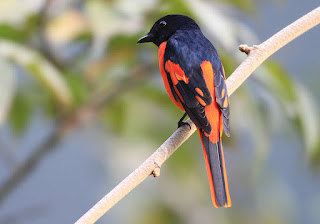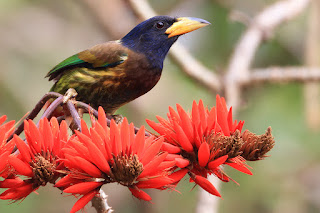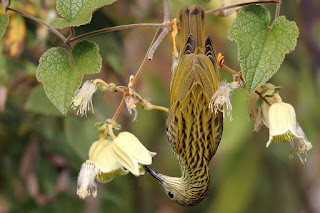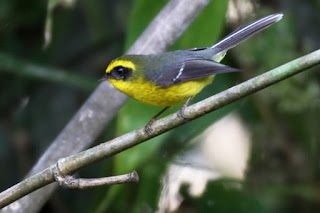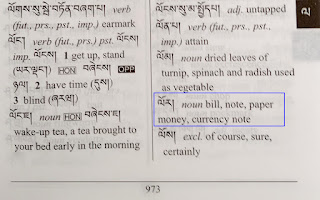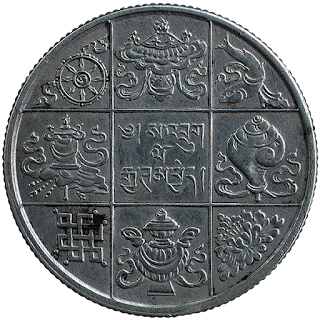Monday, January 31, 2022
Yet Another Lifer
Saturday, January 29, 2022
Two Lifers In Two Weeks!
Among the world bird watching community, there is a term called “Life bird”. I do not know if the bird photographers’ community uses the term - but I accept the term in my own photography. The term means that a bird watcher is seeing a particular bird for the first time in his/her life – a lifer as the bird is known. Thus for me too I got two “lifers” during the past two weeks of good fortune of being incapacitated by the ongoing lockdown. This should be a record of some sort – I mean you don’t see two lifers in two weeks – people travel thousands of miles to see a lifer and yet they don’t.
The following are my lifers:
As I have said many a time in the past – not all situations are a curse for everyone – for some it is a boon.
Thursday, January 27, 2022
My Beautiful Lockdown Birds
Wednesday, January 26, 2022
Bird Photography I: Tricks of the Trade
Some friends and readers have been asking me to write more on bird photography and how I manage to get such sharp images. Well, today the day is bright and sunny – not the ideal conditions for bird photography. Thus I am willing to be distracted to write out this post.
During a bird photography exhibition in Dacca, Bangladesh some years back, I was ask to do the same – to give a talk on how I do it. The following are the points I made during that talk – the rules I follow when shooting birds. And I am rigid about the rules. Since I adopted the rules, I never broke them – even when certain situations called for breaking them.
1. HARD WORK
Top of the list is hard work. There is no substitute to hard work. I work very, very hard to get the kind of images I want. Without working hard, I will not get what I want.
2. ASA
I never, never, never, never, never shoot above 100 ASA, not even in desperate situations. At times I am tempted to crank up the ASA, like most other photographers do – to gain higher shutter speed when challenged with poor light conditions.
When I am presented with an opportunity to shoot a lifer (a new bird that I have the opportunity to photograph for the first time in my life), I am tempted to break the rules – but I don’t. Instead, I forego the opportunity of a lifetime. I could very well break my own rules and crank up the ASA because higher ASA means faster shutter speed. But that isn’t my aim – I am experienced enough to know that although I might get the images, they will most likely be grainy and soft. And if you are unable to frame the image properly and position the bird at the correct angle, because you are too far away or positioned in an inappropriate position, it will call for post-shoot cropping – to eliminate the unnecessary space and clutter around the bird. You can imagine the result – TERRIBLY FUZZY IMAGE.
My philosophy: What images I cannot use, I do not need.
3. FRAME RATE
Unlike most wildlife and sports photographers, I NEVER, EVER SHOOT continuous/multi-frame images. I shoot one frame at a time. Even during my photographic assignment to cover the fast paced tennis tournaments at the Wimbledon and Shanghai Masters, I was following my self-imposed rule – one frame at a time – inviting quizzical looks from other photographers around me.
Some very senior bird photographers are aghast at this rule – but they acknowledge that it would explain the clarity and sharpness of my images.
The reason is that multiple frame shooting means that the reflector mirror inside the camera will be flapping wildly, in the process jarring the camera body. The jarring results in camera shake – meaning the images will not be as sharp as it should be. Ofcourse now there are camera’s that are without mirrors. However, I am not sure that they are equipped with the traditional EF lens mounts. I am unlikely to find out since all my lenses are EF mount and it will be hugely expensive to migrate to mirror-less camera bodies because that means I need to buy whole new set of lenses costing me millions.
My endeavors will be NOT to take thousands of frames of images that are blurry. My aspirations are for just ONE FRAME that is sharp, well composed and well lit up.
4. TIME OF DAY
I never shoot during sunny days. I shoot from around 7AM until sunup. Generally birds are not very active during day anyway. But if the light is bright (not sunny) I will chase the birds. However if the sun is up, I will not shoot birds since the birds’ feathers reflect light and the colors come off all wrong. Thus the images are useless. I also shoot after sun down – but not for too long after it. A dull light is no good for bird photography – not even for any other photography – portraiture or scenery.
This is not to say that sunny days are all bad. There are situations when you will find that some isolated pockets are in the shade. You could find birds in those.
5. SHUTTER RELEASE
Generally photographers tend to be in a rush to photograph the bird the moment he/she sees it. That is the wrong approach – and a sure way to lose your bird. I take my time. I allow the bird to settle down – allow it to get used to my presence. No sudden moves …. easy and casual and totally unimpressed. Because bird photography is all about long lenses, we have to make sure that there is no camera shake – because the shake produced by a long lens is even more pronounced than those produced by shorter focal length lenses. Thus even when I begin to shoot ---- I make sure that the shutter release button is the only part of the camera that experiences a pressure – precise and concentrated on the shutter release button. Rest of the camera and lens must not feel the pressure during the process of depressing the shutter release button. Or there will be shake – resulting in not very sharp images.
Look at the following two images – how sharp the images are and how beautifully I controlled the lighting and exposure. If you look at the image of the Ibisbill you will know how sharp the image is – you can practically count each and every scale on the leg of the bird. Then take a look at the image of the Scarlet Minivet – and you know what I mean by perfect and well controlled exposure. The colors scarlet and black are at opposite ends of the contrast scale – very strong colors individually ----- This calls for striking a balance between the two – to ensure that you compensate for both. As you can see, I managed that very well - you can see that the exposure is so well controlled that there is not a hint of over or under exposure of the individual colors – black comes off as black and the scarlet is beautifully scarlet! A mismanaged exposure would have ruined he image completely.
These are the five principal tips I have for the aspiring bird photographers – rest are less complicated but requiring of experience and skill that you will develop over the years. But as you know, the climb to the summit is a laborious one – there are no shortcuts – you have to keep trudging up - few feet at a time.
ENJOY!
Tuesday, January 25, 2022
Time For A New Generation - New Breed of Bhutanese
In my Blog post of 20th January, 2022, I made a distinction between “Dasho” and “Draksho”. I know that very few, if any at all, would have stopped to think through the implications of what I meant. That is why I have said many times in the past that the Bhutanese are not a thinking society – we do have a mind but it is akin to a bottomless pit – it can absorb any amount of information poured into it – but we will not process the information.
Yesterday morning’s following Kuensel article proves my point.
And yet, the government calls it “Human-wildlife Conflict” – an outright mindless utterance! If they had a mind, they would know that there was never a conflict – the wildlife walked in, grabbed the animals and birds and destroyed the crops, and walked away scot-free.
According to the Kuensel article the Forestry official claimed that the affected villagers do not share information about wildlife predation. On the contrary, the villagers claimed that the Forest authorities ignored their requests – thus they stopped informing them.
Now who are the liars here?
Sadly this has been going on for many decades – and in all likelihood it will perpetuate for many more decades – unless His Majesty does something dramatic - other than cajoling His subjects every National Day, year after year.
His Majesty would have by now realized that this generation of dashos and sycophants are totally beyond redemption. It is clear that every effort of His Majesty at course correction will come to naught – because His subjects will never, ever improve. However, His Majesty still has more than a quarter of a century left to rule this country. But like one of my readers commented, “No amount of squeezing the same old pebbles is going to expel oil”.
I wish and pray that His Majesty consider my idea – that of starting 6 new large schools in the rural areas. Populate them with children aged no more than 5 years. Begin the process of molding their minds and instilling in them the long lost values of duty, dedication, selflessness, commitment, responsibility and patriotism. Start afresh with untainted and unblemished minds – from the ground up – on a clean slate.
Create a whole new generation of Bhutanese who will grow up to be different from their parents – a totally new breed of Bhutanese who are nothing like this generation.
If His Majesty were to start now, by the end of his reign in about 25 years from now, He would have created a whole new generation of Bhutanese who will respect the rule of law, who will understand that selling car quota is a shameful crime, that being responsible is more than fulfilling a duty. His Majesty would have ushered in an era where citizens will aspire to be Drakshos rather than be dashos; take pride in doing their duties with diligence and dedication, and above all, value others’ time, including their own,
But one thing baffles me – who will administer these new schools and who will teach the children? Well, we will need to get around this perplexity, somehow.
Sunday, January 23, 2022
Bird Photography for the Artists, the Ornithologists and the Birdwatchers
Over the years I have been requested to give lessons on photography – particularly bird photography. I never really got around to do it. A friend tells me that he is opening an institute sometime in 2024 and informs me that I stand booked – to give photographic lessons. Very optimistic – for all you know we could all be consumed by this raging COVID-19 pandemic – the epicenter of which is now bang in the heart of the country.
I am not sure that people understand why they would want me to teach bird photography to a bunch of novices. Firstly, it is a very difficult and tiring profession. I am unwilling to believe that there are many people who are willing to put in so much hard work. Secondly, it is an expensive affair. Thus even if I teach them the ropes, I do not believe that even 0.01% of the students will have the wherewithal to pursue the profession, beyond the classroom setting. Lastly, what you do not know is that the whole natural world is working very hard at obstructing you – it puts all sorts of obstacles on your path – to ensure that you have a hard time getting a good clear shot of the bird you are chasing. But if you do get the image you want, it can be very satisfying. Look at the following images – they are well controlled in terms of lighting, sharp, clear, perfectly framed, the positioning of the subject is spot on, and the birds have been perfectly isolated from the clutter on all sides. Best of all, I have managed to capture the twinkle in the eyes of every one of the birds. As in portraiture, bird photography is also all about the eyes. If you can get the eyes well focused and sparkling, you have done a good job.
As you can see, the bird is shown in four different positions – the right side, the left side, the front side and the rear side. For those lot who are called Ornithologists, they want to see the colors, the wing pattern, how they look from different angles, their flight pattern etc.. Same is the case with birdwatchers – they just need an image of the bird to prove that they have seen it – claim without proof sounds hollow. Thus, the bird may look like it was photographed in the thick of monsoon in London – but that will still qualify as proof and take the birdwatcher’s standing a notch up among his peers.
Saturday, January 22, 2022
Kholongchu Hydropower Project: Coming or Going?
Friday, January 21, 2022
My Life's Second QUOTA
Thursday, January 20, 2022
LOCKDOWN: A Strange And Unusual Problem
When a lockdown was declared in Thimphu four days back – not many were surprised. Most of us have been expecting it. I mean proactive leadership by His Majesty the King and strong containment measures by the government notwithstanding, few cases of leakages were to be expected – it would be paranormal if Bhutan did not record any community infections, particularly given that the blasted thing has been going on for the past 2 years. Three more days of lockdown is justified – regardless of the inconveniences it causes.
The problem with lockdowns is that it causes a very strange and unusual problem – tiredness brought on by having to do nothing!
Long periods of inactivity can be terribly unnerving. What can a man do? – hour after hours and days of being confined within a limited space can wreck havoc on your patience and tolerance level. The monotony can get frustrating.
On the second morning of the lockdown, I decided to treat myself to an assortment of activities. I began by vacuuming my car and meticulously wiping the dashboard and other plastic and rubber paraphernalia clean of dust and grime. Then I pulled out my water jet/spray system and washed my car to a subdued shine.
With still plenty of time in hand, I looked around to see what else I could do. I noticed that the drain was quite simply filthy - cluttered with pebbles, swollen grains of discarded rice, onion peels, cigarette butts, rags and numerous waffles of dried red chilies from some castaway Emma Datsi.
I began to jet-spray the drain with my water jet system, making sure that I control the force of the jet so that the plasterwork do not peel off. It took me a while because the damn drain runs into over three hundred feet long and the work is a laborious one. But at the end of my endeavors, the drain was squeaky clean and free of years of muck and filth. That done – I still had time in hand. I realized that the compound around the building was strewn with trash.
So I put on my hand gloves and started to pick the trash and deposit them inside a double-layered trash bag. In the middle of it all, my wife comes out of the house and taking on a posture of an indignant Mama-san, wants to know:
“Why are you picking the trash? We do not throw trash around – they are the ones who do. So they should do the cleaning. Why should you do it?”
I replied:
“That, you see Madam, is the difference – that is the reason why I am a better person than they are.
“That is why they are the Dashos, while I am the Draksho!!"
She gives me a quizzical blank look and tells me:
“Whatever …. up to you.”
Wednesday, January 19, 2022
It Came, Made A Difference And Quietly Disappeared Out Of My Life
Like everything else in my life - my professional photographic journey too began as a result of a moment of extreme emotion. Even before that, it began with a bungle by a friend in the US of A. She was due to arrive Bhutan for a visit and I had requested her to buy me a good idiot’s camera – the point-and-shoot variety made by OLYMPUS. She failed to follow through instructions – and instead bought me a DSLR by Canon – EOS 10D – Canon’s first digital SLR. If that were not enough, she paired the camera body with, perhaps, Canon’s sharpest zoom lens to date – the highly acclaimed Canon EF 70-200mm f/2.8L.
I generally scoff at zoom lenses – for me nothing less than primes. However, this beast of a zoom lens is a class apart. The sharpness and the faithful reproduction of colors is simply incomparable – silky, smooth and WOW!
The truth is that this lens is not designed for bird photography – its focal length is too short. But the karmic truth is that this lens is what started me off on bird photography – never to look back.
When my American friend arrived Bhutan and delivered the camera and the lens, I took them for a field test. While driving past Langjopakha bridge, I saw a grayish bird sitting on a large boulder just before the Convention Center – it had 6 insects jammed in between its minuscule beaks. I stopped and photographed the bird.
Much later I got to learn that the bird I photographed was a female Plumbeous Water Redstart (Phoenicurus fuliginosus). It was then Spring – meaning it was breeding season for the birds. Obviously the bird was out on a food-gathering mission – to feed its chicks. When I reviewed the image on my large computer screen –what I saw took my breath away. The mother bird had become extremely scrawny as a result of over work to feed her chicks. My common sense told me that she must have had an unusually large brood to feed, with the result that she had become weak and frail. Generally the bird – both male and female - are well fed and a round ball of feathers as a result of abundant nourishment.
First, the image made me realize just how hard mothers have to work - to care for and bring up their children. No wonder than that they hold a special place in our hearts and minds.
Second, I posted the image on a popular birding website – it immediately hit the top of the charts and set the page on fire. Regardless of the fact that this was my first ever bird image, I got encouraged by the many compliments from birders around the world. Thus began my bird photography journey.
Sadly – I lost the life-altering image – it came, made a difference and quietly disappeared out of my life. To this day I have been trying to acquire a repeat image – without any success.
In memory of that bird image, I present you the following 8 beautiful images from my collection over the years. ENJOY!
Monday, January 17, 2022
Reclaiming My Passion
Now that I have some time for myself, I am able to pursue my life’s passion – photography. Recently I had to go to Zhemgang to participate in the handing-over of a dwelling for a destitute couple, funded by the Tarayana affiliated Bhutan Dragons Motorcycle Club. I took some time off to shoot some birds. I had only one and a half day though – but Zhemgang is so bird rich that I still managed to acquire 10 birds that are what I call “keepers”. Judge for yourselves.
In the coming months, I hope to be able to shoot more birds, while still being able to concentrate on my coin book, which is my immediate primary focus.
Life is looking good.
Saturday, January 15, 2022
Life-long Journey of Charity and Community Service
I may have severed my ties with a charitable organization – but it appears that my journey of charity and community service has not ended. Yet again, I got drawn in into another charity work – that of the donation of a house to a destitute old couple in Tama-Gonphai village in Zhemgang. The donors – Tarayana Foundation affiliated Bhutan Dragons Motorcycle Club – agreed to fund the construction of the house provided I act as the coordinator to the project. Well, why not? It is a uniquely fascinating idea – have fun riding to remote places and at the end of the journey – do a meaningful charity work that bring happiness and cheer in the lives of some poor country men.
Ably managed by the Tama-Berti Chiwog Tshogpa Ms. Kinzang Deki, the project took a little over two months – although severely hampered by the ongoing COVID-19 pandemic. The implementation of the project began on 15th October, 2021. By mid-December the construction of the house, including a separate toilet, was completed. It was handed over to the grateful old couple on the 7th of January 2022.
As has become a norm with me, all my numerous project implementations end with a detailed Project Completion Report to the donors. The following are few pages from my Project Completion Report to the immediate past project donors - Bhutan Dragons Motorcycle Club:
Curtesy of donors around the globe, I have implemented close to 100 projects and have been party to 7 more Rotary Projects that are currently in the pipeline. But one lesson that the latest donors taught me is this: Do not just give an empty house - to make the charity even more meaningful and valuable, populate the house with some basic essentials, such as mattresses, water boilers, rice cooker, curry cooker, buckets etc. etc. This is a life-lesson I will remember in my future charity endeavors.
I am happy to say that this project is the second project that has been implemented with quality and speed, due solely to the hard work of the Tama-Berti Chiwog Tshogpa and hassle-free funding by the donors. The other community service project that was implemented at a speed that will be hard to match - is the Rotary Club of Thimphu's toilet project in Bongo village, Chhukha Dzongkhag. Due to the hard work and diligence of the coordinator there - Mr. Sangay Thinley, the incumbent EDO of Chhukha Dzongkhag Administration, the construction of 36 detached, pour-flush toilets with bath facility was completed in record 35 days!
Friday, January 14, 2022
Traditional Bhutanese Term for Paper Currency
My Blog post of Wednesday the 5th January 2022 titled “Rewriting History” touched upon the term “Shog Lor” and my confusion as to the meaning of the word “Lor”. I finally got around to find out the meaning of the word. The following is an extract from the Dzongkha-English Dictionary. The meaning of the word is explained without any ambiguity.
According to the Dictionary, the term “Lor” will accurately describe paper currency, without the need to add the word “Shog” in front of “Lor”. Thus I am not correct when I say that “Shog Lor” means paper money. Lor by itself means: bill, note, paper money, currency note etc.
I am sure that most of you are unaware that the traditional Bhutanese term for currency notes of 1, 5, 10, 20, 100 and 1,000 Ngueltrums are:
Chaang Lor, Nga Lor, Chu Lor, Khae Lor, Ja Lor and Tong Lor.
There is something insane about the way our monetary units have been called: “Ngueltrum” and “Chettrum”.
“Ngueltrum” is a combination of two words “Nguel” (silver) and “Trum” (coin). It specifically translates to: Silver Coin. Strangely we employ this term to describe our paper money.
“Chettrum” is also a combination of two words: “Chet” (half) and “Trum” (coin) – collectively meaning: half coin. I believe that the term was coined during the time of the issue of our first modern milled silver coin – the Silver Thala of 1929. The reverse of the coin is inscribed with the words “Sa Druk Lo Ja Trum Chet”. The words translate to: “In the Year of Earth Dragon Half Indian Coin”. It could be argued that “Ja Trum Chet” could mean “half of hundred”. But remember that those days we did not have monetary denominations of Nu. and CH – so it could not have meant that Thala was half a Ngueltrum.
I have been calling for the correction of our monetary units – but who cares?
Tuesday, January 11, 2022
Drin Jorpa Warey
This is the second time that has happened to me.
The first time was when my mom was about to pass away – it was as if she knew for sure that her moment had arrived. It was in Gelephu sometime in the late 1970s. My mom was bed-ridden – she was suffering from cancer. One afternoon she called me to her bedside and took my hand into hers. She removed her gold ring from her finger and inserted in into mine, saying:
"Okai ngai shuijab wen warey – Ngatna khachem jang labtemen mooth – pholab theg labtey weth na. Wii werai aama na drinlab khaba khriba jorba warey. Weth nyai bo buzey ngat sonam sakna."
"This is my parting gift to you – I have no last words for you. But I want to tell you something. Please know that you have fulfilled a son’s duty and obligation to his mother in full. I have been blessed to have you as my son."
Hours later she breathed her last.
The second time was on the 7th of this month. I had gone to Tama-Gonphai village to participate in the handing over ceremony of a house built for an old destitute couple by the Tarayana Foundation affiliated Bhutan Dragons Motorcycle Club. After the ceremony was over, I walked over to the old lady to ask if there was anything else they needed. She said she needed nothing more, adding:
"Wii mebran – wheth chiingku buzi nyigmo ngui weth nyai kaidoh sama bakpa. Dusoom wii osokai maigey roram buzey ---- we ngatna drinlab khaba khriba jorpa warey."
"You do not know – but when you were a child I carried you on my back many, many times. Please know that today with your participation in this house donation, you have paid your debt to me in full."
I was clueless about this - but that is not important.
No less touching was a letter of farewell written to me by Rotary Club of Thimphu’s Executive Secretary – Ms Tshering Choden. The letter was waiting for me on my table when I returned from Zhemgang on the 8th – it read as follows:
The Club President and the Club Secretary wanted to give me a farewell dinner – I declined saying that the Club was poor and could not afford it. I did not need a dinner that would cost between Nu.20-30,000.00. The letter written by ES Tshering is far more touching and meaningful than any dinner. It acknowledges my relevance – that I have given back to the society from which I took so much.
This letter is my JUST REWARD for my 7 years of service.
Monday, January 10, 2022
Reverse Migration: Restocking The Goongtongs
Sunday, January 9, 2022
The Repossession Of My Life - The Journey Begins
Hi ......,
Thank you for your mail ---- and I am sorry for the slight delay in reply. The truth is, now that I am fully relieved of my responsibilities at the Rotary Club as of January 1, 2022, I have been finally able to go and visit my ancestral home. I have been meaning to make the visit for a long time but never got the time.
The next lap of my life's journey has now begun.
Yes, as you can read in the Dedication Page of my book, the creation of the DeSuung organization about ten years back was nothing short of divinatory – as if His Majesty saw the future and the coming of the COVID-19. What is even more amazing is that by the time the COVID-19 hit us, the required mass was in place – the number of serving DeSuups were enough to take on the mitigation work at all fronts. Just creating the organization isn't enough – numbers matter – and it was there in full force, which made all the difference. Without the numbers, it would not have mattered.
The face of Bhutan would be totally different today – if the DeSuung were not in place, with the required numbers.
The PowerPoint presentation of my coin book is just a demo – not the whole truth. I just wanted you to see how the book will look and feel.
My narrative on what would have happened to most of the 50,000 silver Thalas (total 2,908 KGs) of 1929 and 1930 that went missing is very interesting I can tell you – but my theorizations are based on documentary proof that point to what may have happened.
A number of Western writers, collectors and historians on Bhutanese coinages had always put the date of Bhutan’s first coinage at 1790. I have discovered documentary proof that the year should actually be 1711.
Thank you for your complement – but it took me years to master the technique of photographing the coins with the clarity, evenness of sharpness and lighting quality that you now see. One collector in Belgium tells me that the coins literally pop out of the pages :)-
Now that I have time in hand, I hope to finalize the book in the coming months. This COVID-19 does not make things easy – but life would be so dull without challenges.
You are right – the Cowrie was used as money in many countries many centuries before salt, and finally metal and paper money – including the Kingdom where the sun never set – England. As you may have read in my demo presentation, in Bhutan we apparently begged Kuber the God of Wealth for it on a daily basis.
7th February is closing in on you very fast! Good luck with your house moving – I just did 3 months back. I can assure you - your biggest headache would be locating things - they seem to disappear.
Bye and take care … and please keep safe and remain vigilant – without loosing out on life's many funs :)-






